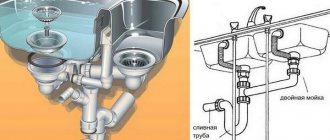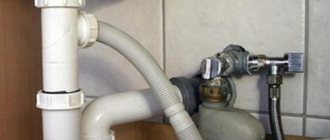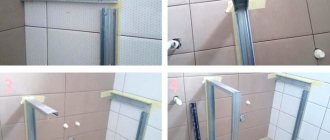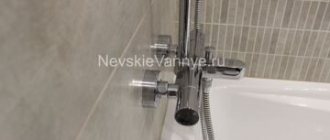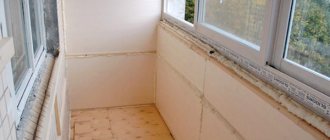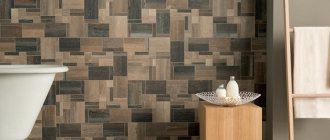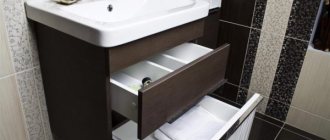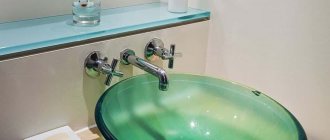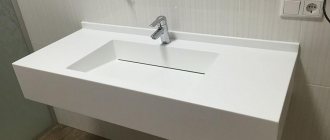Modern people are so accustomed to communal amenities that they sometimes don’t understand how they work. Many of us begin to become interested in this when the issue of repair is brewing.
Thus, installing the same washbasin requires certain knowledge of how to choose a sink drain, install a siphon and connect the system to communications.
Each installation stage has its own nuances, knowledge of which will help protect the drain structure from leaks during operation.
Bottle siphons
These siphons with overflow for sinks have a characteristic shape that looks like a bottle. This is especially true for the sump. Two tubes are connected to its middle part. One leads to the sewer, and the second leads to a place for drainage in the plumbing. If you plan to install a siphon for a washbasin, then, perhaps, there is no better design for it.
- The advantages of this system are ease of installation and dismantling.
Bottle siphon - In addition, the hydraulic valve of the structure can be removed and installed very simply. To do this, you do not need to disassemble the entire structure.
- The bottle siphon provides for the connection of other tubes to it. In particular, the drain from the washing machine.
- A well-known feature of this design is the ability to easily reach missed small items above the sink. They will all be at the bottom of the “bottle”, which is easily detached and replaced.
Among the disadvantages of this system, it is necessary to highlight a large number of connections. As a result, this can cause a leak.
Assembly instructions
Plastic bottle siphon for kitchen sink with drain hole Ø50 mm, with flexible corrugated pipe, sewer connection: Ø40/50 mm, color: white, drain grate screw length: 70 mm, grate material: stainless steel.
Prepare the material for joining and sealing: silicone sealant and a gun for working with the tube. Tools you will need:
- knife, figured and flat screwdrivers, pliers;
- grinder with a circle for metal (not always).
First, the old device is removed. To do this, unscrew the nut, turning the top counterclockwise, carefully pull out the side outlet from the siphon and remove the assembly itself from the sink pipe. The seals must be removed by prying them off with a screwdriver. If they don’t give in, you can cut them off piece by piece with a knife.
The lower end, which is sealed in the sewer socket, is removed by turning from side to side. For convenience, hold the drain pipe with your hand. During replacement, a tightly rolled rag or newspaper is placed in the sewer socket to block odors.
Corrugated and tubular siphons
It is not without reason that this design is considered the simplest of all types of siphons. Externally, it looks like a curved tube. Its fixation is carried out not with the help of threads, but with clamps. On the one hand, this allows you to avoid minor leaks, but on the other hand, it complicates installation and dismantling.
Corrugated siphon
Dropping small change into such a structure will definitely create a headache for yourself in retrieving it. At the same time, a large number of bends and the plasticity of the material make it possible to install it in almost any hard-to-reach place.
- The bottle siphon can be placed in a place with a certain height from the sink to the floor. With regard to a corrugated appliance, the position of the sink makes virtually no difference. Made from corrugated plastic, the siphon bends easily, and its water seal can be placed even away from the sink, thereby saving space.
- On the other hand, a bendable tube clogs faster. After all, the corrugated surface of the tube is not only on the outside, but also on the inside. If such a siphon becomes clogged, you will have to dismantle all its elements. In this sense, manufacturers offer their customers combined models, which at the same time partially consist of corrugated tubes and a bottle siphon.
- A tubular siphon is best installed under the bathtub, however, it is also suitable for sinks. It has a strong, rigid pipe that prevents rapid clogging, but is much more difficult to install. This sink siphon with overflow will require a certain position of the sink in relation to the floor. Often this design simply takes up a lot of space, and if there is a need to install a small sink, then this model should be abandoned immediately.
Let's sum it up
Shower cabin with a steam generator, if you have not yet heard about this newfangled option for the bathroom, we recommend that you familiarize yourself with the details about the operating principles and installation tips in our separate article.
In order to purchase a high-quality siphon, you do not always have to spend large sums - now you can find many domestic and imported models at an affordable price. In addition, their device allows installation without the help of a specialist. You just need to carefully follow all the steps of the instructions, without missing out on the details.
What is overflow
An overflow is an additional tube that is removed from the sink and connected to part of the siphon or its pipe. It prevents water from overflowing over the edge of the sink. The water, having reached the second hole in the sink, located close to its edge, begins to calmly flow down the overflow into the sewer. Thus, flooding of an apartment with such a design is unlikely. Accordingly, recently the demand for such a model is significantly higher than for siphons without overflow.
How the drain works
A standard siphon is a curved pipe with different elbow lengths. It turns out that the liquid from the bowl located above flows into the container located below. The water level is important for the functionality of this device, so it is pre-filled.
Thus, water is constantly located in the curved part of the device. Thanks to its characteristic shape, pressure is maintained there all the time, the drains are renewed, which prevents the spread of odors throughout the kitchen. Waste liquid goes down the drain every time it is used.
For example, liquid flows from a bowl into the outlet. Then it is poured into the bottle, and then into the branch connections. The wastewater is then sent to the outlet compartment and into the sewer pipe.
The principle of the siphon
The drain has the following design:
- body part, which can be disassembled if desired;
- lower outlet pipe;
- protective mesh with cells with a diameter of about 10 millimeters;
- connection screw for the mesh and pipe;
- a tube for discharging wastewater into the sewer;
- gaskets that are fixed between the body part and the pipe;
- plastic fasteners.
Principles for connecting a drain system in the presence of a sink with two bowls
Choosing a siphon for the sink
One of the significant points when choosing a design is the material it is made of. As a rule, manufacturers offer 2 options: plastic and metal. A plastic siphon is the most economical model, which costs much less than a metal one. In addition, its advantages include durability, as it is not subject to corrosion, and quick installation and dismantling.
Plastic siphon
Metal siphons are made from cast iron, as well as non-ferrous alloys of bronze or brass. They cost significantly more, take longer to install, and require a certain amount of space. However, they create fewer problems with blockages and have an elegant appearance.
Metal siphon
The hydraulic valve is an essential element of the siphon, the selection of which should be given additional attention.
- First, you need to decide on its volume. It is best to choose a large hydraulic valve, in which case there will be no problems with its clogging and draining of water. However, in some cases it is impossible to install a large valve - there is no space. A small hydraulic valve is not only a problem when draining water, but also one of the reasons for apartment flooding. The water simply will not be able to quickly go down the drain.
- The second point when choosing is its installation. You can mount the hydraulic valve in a special bedside table, in the base of a sink, or by leaving it in plain sight. In the latter case, you need to worry about decorating it, otherwise it will look ugly and lonely in the bathroom.
In addition, it is worth taking a closer look at the rubber gaskets that are installed in place of the threads in the siphon. Their thickness must be at least 3 mm. If the gaskets are thinner, they will soon become loose and begin to let water through easily.
What does it depend on?
Each kitchen device requires special attention. It is worth paying attention to the type of sink . For example, private houses are characterized by an island-type installation. There are no specific rules; each owner does what is convenient for him.
It is also worth paying attention to the following factors:
- many choose the height of the kitchen module based on their own height or the average value of all household members, then they begin to calculate the allocation;
- The type of sink is taken into account. Today you can often find hidden installations that require precise markings to avoid damage in the future.
Speaking about the growth of household members, the following points can be highlighted:
- if two tall adults live in the house, then it is better to install the sink at a height of 80 cm - this is the distance between the floor to the sink/countertop;
- if there are teenagers, 70 cm is considered average;
- if there are small children in the house - 60 cm.
The average height of a kitchen module is 75-85 cm according to the sanitary standard . Based on the type and model of the sink, the owner independently determines the point for the sewer outlet. If the installation is not of a hidden nature, it is easier to install it according to SNIP standards. Example:
Installation of a siphon with overflow
To do this work, you should carefully read the instructions that come with the product. The greatest attention should be paid to the water seal. Here is a brief outline of the key points for self-installation:
- You should check the recessedness of the mesh on the drain hole. If it is located too high, then the water will not go down the drain efficiently and will begin to collect in the sink.
Siphon installation - A conical gasket and a special nut are put on the outlet pipe coming out from the bottom of the sink. It is necessary to create a gap of 3-5 mm between the gasket and the edge of the pipe.
- When tightening the nuts during installation, do not use a wrench. It is better to do all twisting by hand. By screwing with a wrench, you can put excessive stress on the plastic elements and cause a crack in them. Such a product will be unusable in the future.
- A tight plug must be installed on unused outlets.
- After installation, you need to check the functionality of the entire structure. To do this, open the tap to full power to see how the siphon reacts to high water pressure. On a well-installed siphon, liquid will not ooze from any joint.
This is interesting: Replacing pipes in the bathroom: how not to make mistakes during repairs
To prevent leaks, it is necessary to use sealant during installation. However, it must be used carefully, since in the future such a structure will be very difficult to dismantle.
Recommended sizes
In order to select the required pipe diameter for sewerage, you can use the recommended values for performing such work. It is important to understand that the information provided may change in any direction and depend on the characteristics and features of the plumbing or sewage system.
When equipping internal sewerage, it is recommended to use the following sizes of PVC sewer pipes, according to the table:
- 11 cm . for the toilet, as well as the riser.
- 4-5 cm . for connecting a bathtub, sink, bidet, sink or shower.
- 2.5 cm . for connecting a dishwasher or washing machine.
- 5 cm for connecting a combined drain or setting up wiring.
- 6.5-7.5 cm . for bends.
When equipping external sewerage, it is recommended to use the diameters of PVC sewer pipes, according to the table:
- 11-16 cm for external pipeline installation (the choice of option depends on the volume of wastewater).
- 15-20 cm . for connecting a sauna or bathhouse.
- 20-30 cm . for connecting the pool.
What types of siphons are there for washbasins?
The washbasin is an important element of the bathroom, through which you can carry out water procedures in the morning. But in order for the device to always function normally, it is necessary to equip it correctly. It is important that the design contains an element such as a siphon. Thanks to this device, it drains the overflow, protects the sink from overflowing, and also eliminates unpleasant odors. So which siphon should you choose for a washbasin, what are the rules for choosing, what should you take into account when purchasing. It is worth considering these important points carefully.
Siphon device
The washbasin siphon has a simple design that looks like a pipe or a series of pipes that are connected using a regular flask or curved pipe. But it is worth considering that modern manufacturers are trying to improve these products, so many of them no longer look the same as before.
But there is a standard set of siphons that has existed for a long time. The standard kit includes the following items:
- mesh or protective grille - usually this element has several, 5-6 holes, which have a diameter of 1 cm. This mesh or grille is installed in the washbasin; you can see this element in the sink in the morning while washing your face in the morning or evening and cleaning your teeth. The base of the element can be made of metal or plastic;
- gaskets made of rubber material - the thickness of these products prevents water from seeping through them from the washbasin down to the floor. For expensive ones, white gaskets are usually used, and for cheap ones, black;
- outlet pipe - this element is usually used to connect additional devices, a washing machine or dishwasher;
- the connection between the protective grille and the pipe is made using a screw with a diameter of 8 mm;
- the siphon body is the basis of the entire structure;
- sewer outlets - these elements can be corrugated or rigid;
- connecting nuts.
This is interesting: Choosing an automatic bath siphon
Siphon device
Siphons must have stainless steel connecting screws, so it is worth carefully checking the composition of these elements. If they are made of ordinary coated metal, they will soon rust and the entire siphon will have to be replaced.
Types of siphons for washbasins
What types of washbasin siphons are there? This question interests many apartment owners who are starting to equip their bathroom. If you do not know which siphon to install, then you should carefully consider its types and design features. What types of siphons are there for sinks and washbasins?
Corrugated
Corrugated siphons are made of a pipe made of plastic material with a folded structure. Due to the fact that this product has a folded type, it can easily fold and unfold and take any shape.
Positive design qualities:
- the corrugated siphon has increased plasticity, which allows its device to bend easily;
- flexible design allows this device to be squeezed into a small space under the sink and connected to the drain;
- a small set of components - a pipe and a connecting unit. This design reduces the likelihood of leaks.
Designs with a corrugated structure have negative features:
- products with corrugation have low resistance to high and low temperature conditions. Do not allow too hot water to enter the device or ice to appear in it;
- Fat gets into the folds of the corrugated base, which leads to blockages. To clean the product, you will need to completely dismantle the entire structure.
Pipe
Pipe structures are made in the form of a curved pipe made of a plastic or metal base. In the area where the pipe bends, a water seal is observed, but it is not very deep. For this reason, when this siphon is not used for a long time, the water begins to evaporate, and as a result, a musty and unpleasant odor is observed. The siphon of this type of washbasins and sinks often becomes clogged, resulting in the formation of blockages. These devices have to be disassembled and cleaned frequently.
Due to the fact that this type of structure often gets clogged, it needs to be constantly removed and cleaned; it is inconvenient to use for the kitchen, because in this room you have to often use the sink and wash the dishes, which often results in blockages.
The siphon has an unpleasant feature - it is too large. For this reason, when installed, it will take up too much space under the washbasin. Apart from this device, nothing else can be placed there.
Tubular products can be used for double washing. These designs have two entrances and screens that can be installed in two sinks. This quality is especially convenient when the bathroom is large but has one drain pipe.
Bottle
The bottle siphon for the washbasin has this name because its middle part looks like an elongated flask or bottle.
This type of design has important qualities:
- installation of products is quite complex, so it is better to have them installed by professionals;
- You can disassemble and clean the components of the bottle siphon yourself;
- a unique feature of the products is that you can connect the drain from the dishwasher and washing machine directly to them, without using an additional drainage outlet;
- the design of this type has a positive quality, due to which these products are in demand. If small objects or debris get inside the siphon, everything can be easily removed by simply removing the lower part of the structure;
- These designs can be used for double plumbing fixtures and for sinks with overflow.
Dry
The dry type siphon appeared not so long ago. Due to the fact that the devices have a special type of device that prevents water from stagnating, they are mainly used in dachas where there is no heating.
When water enters, the rubber membrane opens. Water flows through the membrane device, like through a pipe. As soon as water stops flowing, the membrane contracts and the flow hole is blocked.
Flat and hidden
Flat products have a special type of drain hole. A flat siphon is used when bottle and corrugated structures are too large and are not suitable for small bathroom spaces.
The peculiarity of hidden products is that they are not visible to others. The structure is located behind partitions, inside niches or walls. Typically, these structures are mounted next to sinks that are mounted on walls or installed in open areas.
Flat
Hidden This is interesting: Sewer smell in an apartment or bathroom: causes and solutions
Material of manufacture
An important quality of siphons for sinks lies in their constituent base from which they are made. Their service life depends on what material they are made of. Therefore, it is worth considering the types of materials and their features.
Metal
Metal structures are installed under washbasins, which are covered with a cabinet. They can also be mounted inside a pedestal. In appearance, these products look aesthetically pleasing, luxurious and quite expensive.
Metal products can be of several types:
- brass;
- chromium-plated;
- copper;
- bronze.
Bronze
Brass
Copper
Chromium-plated
The chrome siphon is especially in demand because it has a durable construction. The material from which this product is made retains its qualities for a long time and is not subject to negative influences. In addition, the chrome siphon looks beautiful and rich. It goes well with heated towel rails, faucets, curtain rods, and door handles. However, if you decide to choose a chrome-plated siphon, then it is worth remembering that you cannot do without proper care. Otherwise, the siphon will quickly lose its shine and become ugly.
When choosing faucets made from a metal base, it is worth considering that they are in harmony with the overall design of the room and match all the objects in the room. For a classic, vintage interior style, it is recommended to use products made of brass, bronze, and copper alloy.
How to choose the right diameter
In addition to the diameter selection algorithm, it is worth mentioning other subtleties of sewer installation.
- A horizontal sewer pipe cannot have a diameter larger than the riser into which it discharges wastewater; in general, any narrowing in the water flow is a potential blockage site.
- All horizontal connections are mounted only with oblique tees and angles. Right angles are permissible only when connecting a horizontal section to a riser. This rule allows you to avoid problems when cleaning the sewer.
- At all sewer bends, it is mandatory to install inspections and cleaning holes equipped with covers. An exception can be made for those cases when, for example, a tee for connecting a washbasin is located nearby - if necessary, it will perform the inspection function.
Inspection for sewer cleaning
- In the risers of multi-storey buildings, inspections are installed every three floors . In blind horizontal sections longer than 12 meters, an inspection will also not be superfluous.
- the sewer riser must be open at the top. This is necessary for air suction: we don’t want the vacuum when flushing on the lower floors to suck in the water seal from the upper toilet, right? Aromas without a water seal will quickly fill the entire apartment.
- The desired slope of a horizontal sewer pipe is from 1 to 2 centimeters vertically per meter horizontally. If it is more, the water will make louder noise when draining, and it will begin to silt more. Less - the water will drain unacceptably slowly.
From top to bottom: too little, normal and too much slope
- If the sewerage system is laid under a screed, it is advisable to wrap it with rolled thermal insulation: the noise of water in it will be much less annoying.
- Plastic sewer pipes with diameters of 40 - 300 millimeters can be cut perfectly with both a hacksaw and a grinder. In this case, the cut is very smooth and without burrs. After the required piece is cut, the pipe is chamfered.
- The sewer needs to be fixed every 10 diameters.
- Plastic sewer pipes with diameters of 40 - 300 millimeters during installation need to be left with space for thermal expansion. Having inserted the pipe into the socket of the previous one, do not push it all the way: it is better to leave about half a centimeter. Then, when draining hot water for a long time, there is no risk that adjacent pipes will be damaged.
- Counterclones are not allowed . The entire sewer system is installed so that the pipes are directed towards the flow of water.
The sewerage system was laid correctly, but the corrugation from the bathtub lay with a counter-slope. Blockages are inevitable...
Do not neglect these simple tips when installing sewer pipes - and it will not create problems for you in the foreseeable future.
Did you like the article? Subscribe to our Yandex.Zen channel
Device classification
There are two main classifications used:
- by design features;
- according to the method of removing liquid.
According to the design features, the siphon for air conditioners can be of 4 types:
Device with water seal
It has an arched shape. The two tubes are connected to each other by a special element in the form of an elbow. The knee plays the role of a water seal mechanism. This type of siphon is simple and popular, but has a number of disadvantages: large size; an excellent environment for the development of fungus and bacteria, which can spread to the air conditioner itself; With rare use, the water in the unit dries out and an unpleasant odor spreads from the siphons.
Unit with water seal and odor-locking mechanism
It is similar in design to the first type, but has a small ball-shaped valve that limits the spread of odor from the body. The valve freely allows condensate from the split system to pass through, but does not allow liquids and odors from the sewer to pass through. Such models are complemented by devices for collecting dirt and cleaning pipes.
Boxed device for flush mounting
The entire condensate drainage system is located in a square (rectangular) plastic box. There are 2 pipes connected to the box: from the system drainage and to the sewer. The elbow with the ball odor-locking device is located in the box. The device operates on the principle of a float; when water enters the siphon, the ball that closes the hole into the sewer floats up. As soon as the water leaves the device, the ball, under its weight, closes the hole again.
The siphon is designed in such a way that, if necessary, it can be easily removed from the box for cleaning and replacement.
Dry aggregate
Used in cases where it is not possible to install a conventional condensate drainage device. The siphon is equipped with a compressed rubber tube, which perfectly inhibits the spread of odor. It allows condensate to pass through using the drip principle: the valve opens as liquid passes through and contracts again.
This dry siphon is used in combination with a straight adapter and a funnel.
According to the method of removing liquid, the siphon for air conditioner drainage can be of 3 types:
- with vertical outlet;
- with horizontal outlet;
- combined type.
The siphon for air conditioners is mounted in two ways. If possible, the device is hidden in the wall. A special niche is made for this. If there is no way to hide the unit, it is mounted openly, along the wall.
Manufacturers of siphons for climate control equipment:
- Profcool (Russia).
- Vecam (Italy).
- HL (Austria).
